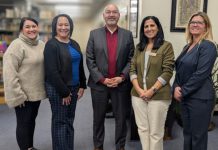The new high school is in jeopardy of being trimmed back or
delayed unless the school district can extract voluntary
contributions by late August from developers who would rather delay
discussions than hold them in public, district officials said.
Open meeting concerns prompt a new date for developers, city and district
n By christopher quirk
Staff Writer
Gilroy – The new high school is in jeopardy of being trimmed back or delayed unless the school district can extract voluntary contributions by late August from developers who would rather delay discussions than hold them in public, district officials said.
“We’re coming down to the wire to not have the funds for the new high school,” trustee Jaime Rosso said. If developers do not agree soon to future contributions, trustees must ask, “Do we put the new high school on hold or do we cut back on the plan to account for the fact that we don’t have the money?”
The Gilroy Unified School District is set to vote in late August to award a bid to construct Christopher High School, but might not have the funds or would have to borrow money to pay the selected bidder. The district has a $14 million facilities deficit, which they hoped developers would help shore up through a voluntary fee increase from $2.63 to $6.61 per square foot of new housing they build.
Developers, while supportive of the idea, have not specified the donations they would make in the four meetings they have attended in the past four and a half months. In addition, they recently cut short a meeting because they did not want their conversations to be public. The parties will not meet again until Aug. 6.
The meeting was scheduled as closed, with members of the board of education, district staff, City of Gilroy councilmen, city staff and area developers in attendance. The Dispatch contacted councilmen Tuesday morning to inform them the meeting might be in violation of the Ralph M. Brown Act, which requires open government meetings. City and district representatives, uncertain about the case law involved, decided at the start of the meeting to open it and have their legal teams research the matter for future meetings.
In response to the opened meeting, developers held a 15-minute private conference with city, school and media representatives waiting outside the room. They reported afterward that they would rather wait for reports from the city and district legal teams.
“This is a community challenge and we’re all here to step up to that challenge and we want to be able to meet in the most conducive environment where there’s a free exchange,” said Lee Wieder of Access Land Development Services.
Developers have complained of press coverage at past meetings. The Dispatch ran articles in May, June and July reporting how developers, initially enthusiastic at a March 2 joint meeting, came back to later meetings with no clear plan and insisted the community share the burden of shoring up the district’s deficit.
When Mayor Al Pinheiro asked developers whether they would continue discussions if the legal teams reported that case law dictated the negotiations be public, developers held a second private conference. While some developers were willing to continue talks, other developers were not, said Tony Sudol of ACS Ventures after the conference.
The delay could force trustees to push back the high school construction or trim back initial expenditures, such as not furnishing the classrooms or eliminating practice fields, said Steve Brinkman, assistant superintendent of administrative services. However, the cost of later furnishing the classrooms or adding the practice fields would be higher. The district could also extend its payment process, which could also raise costs and delay the project’s completion.
As the future of the high school is at stake, the public has a right to hear about conversations with developers, said Tom Newton, general legal counsel for the California Newspaper Publishers Association.
“They’re doing the public’s business,” he said. “It’s a matter of high public importance and … I’m hard-pressed to think of any good reason why they should be discussing this issue secretly.”
When asked what issues could not be discussed in public, two developers did not name any items, saying only that conversation would be constrained. An additional three developers refused comment.
The developers do not want the discussion to be public in part because some developers are going to be less willing to contribute than others, Rosso said. For instance, Erik Keller of the Glen Loma Group has expressed on two occasions that he believes his company, through construction and monetary contributions, has already given enough.
One developer eager to contribute, commenting on the condition of anonymity because he did not want to break ranks with fellow developers, echoed Rosso’s opinion.
“Right from the beginning, we thought it was a simple matter,” he said. “The most important investment is the investment in our next generation of kids. Based on the data presented here, we trust the school board’s data. We never thought it would come to this complicated a discussion.”












